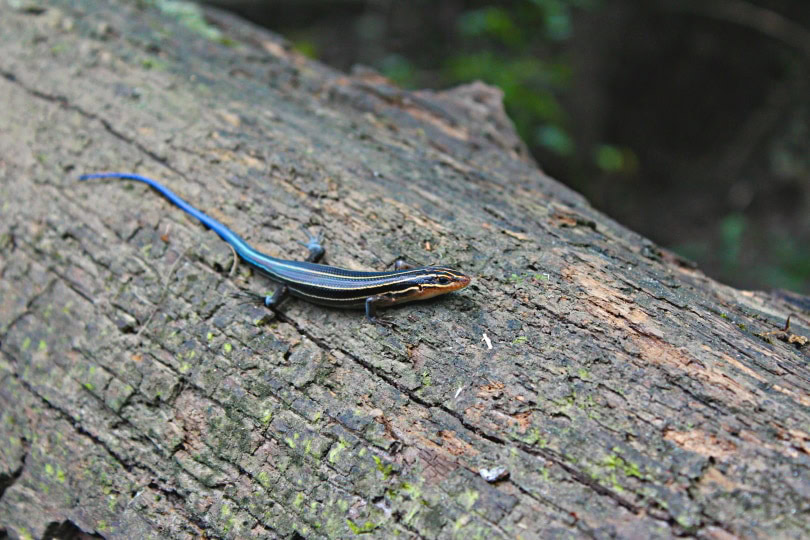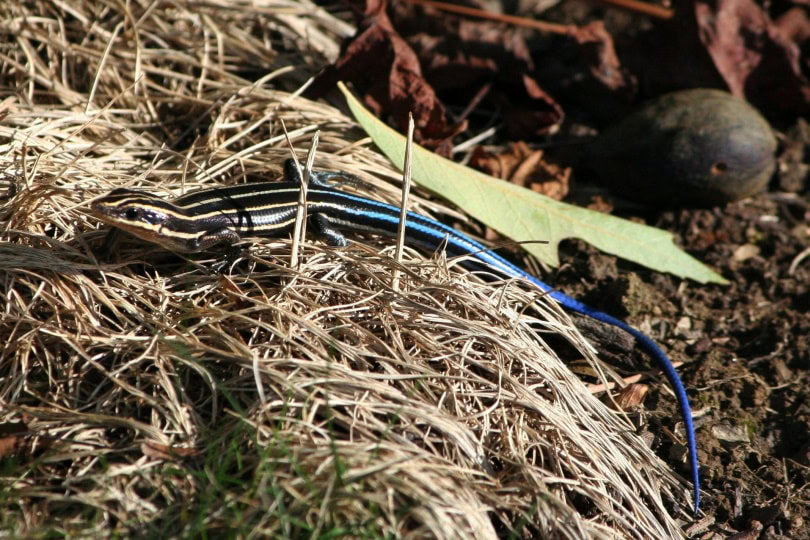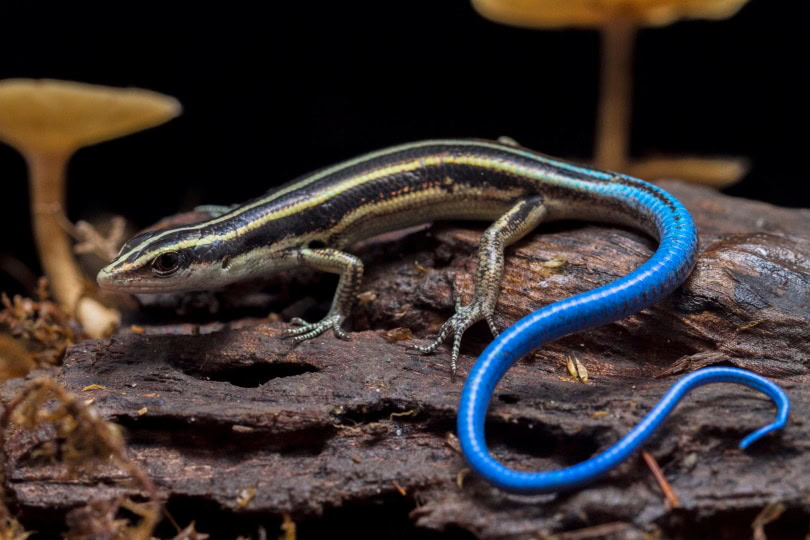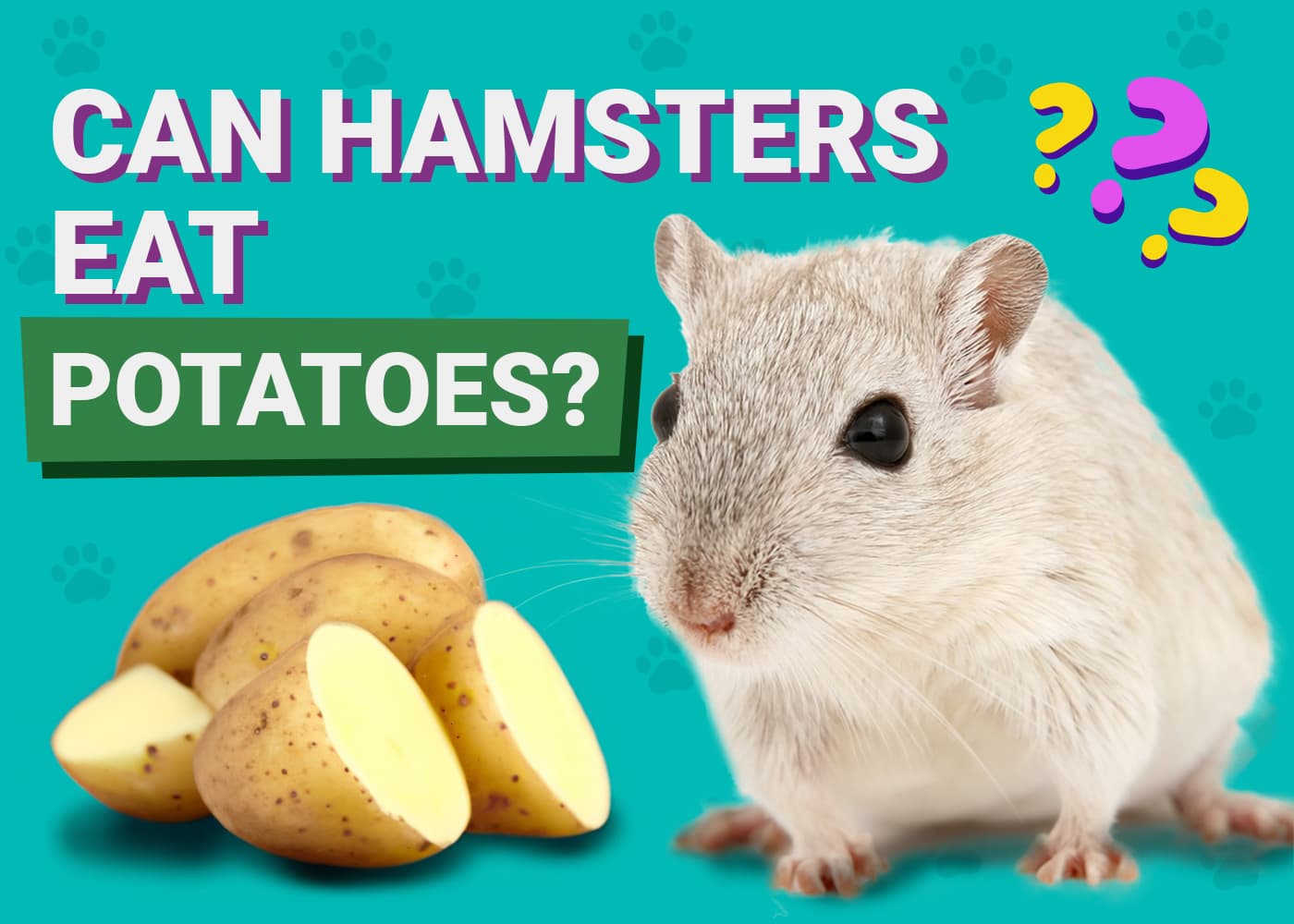VET APPROVED

The information is current and up-to-date in accordance with the latest veterinarian research.
Learn more »Click to Skip Ahead
Blue-tailed skinks are impressive lizards that love to chow down on a wide array of foods. If you have one of these beautiful lizards at home, what should you be feeding them, and how does that compare to what they eat in the wild? Blue-tailed skinks’ diet consists mostly of insects in the wild.
Furthermore, why should you feed a captive blue-tailed skink anything different from what a wild one eats? We break down everything that you need to know about these lizards’ diets here.

What Do Blue-Tailed Skinks Eat in the Wild?

These small critters are primarily insectivores in the wild, but they’re also a bit of an opportunist. Here, we highlighted five different food sources that they’re likely to come across and eat in the wild.
Insects
Almost all of what a wild blue-tailed skink’s diet consists of is insects. They’re not picky about them either—ants, flies, grasshoppers, crickets, and whatever other insect they can find is what they’ll eat. They also have decent success with mealworms and other small insects that can’t run away that fast.
Arachnids
Did you know that spiders technically aren’t insects? Technically, they’re arachnids, but the blue-tailed skink doesn’t seem to mind much when they gobble them down.
- You May Also Like: Largest Spider Species in the World
Lizards
If a wild blue-tailed skink comes across a smaller lizard, there’s a good chance that they’ll try to eat it. But this is one food that a wild blue-tailed skink eats that you should never feed to your pet skink. The blue-tailed skink usually wins the battle, but they often get injured in the process, and over time, those injuries can kill them.
It’s no wonder that a wild blue-tailed skink prefers to stick with smaller prey, like insects and arachnids, when possible.
Veggies and Fruits
While wild blue-tailed skinks thrive on insects, they can do reasonably well on a heavily plant-based diet too. So, if they’re not catching enough insects in the wild and different fruits and veggies are available, they’ll undoubtedly chow down.

What Do Blue-Tailed Skinks Eat as Pets?

A blue-tailed skink’s diet in captivity is a bit different. That’s because they generally don’t get as much activity, so you need to be more careful what you feed them. The type of food that adults and juveniles eat is quite similar, but adults need to be fed less frequently. A young, growing skink needs to be fed every day, while an adult can usually eat every other day. In either case, you should only offer enough food that they can consume in 5-10 minutes.
It’s also important to keep in mind that the blue-tailed skink is much smaller than some other skink species. Their adult size is around 6-8 inches, with most of that being the tail. They are dwarfed by the blue-tongued skink, which is around 24 inches long.
Let’s take a look at some foods you should include in your skink’s diet.
Insects
Being an insectivorous species, the majority of your blue-tailed skink’s diet needs to consist of – you guessed it – insects! There is a huge array of different types and varieties of insects you can feed your skink, but most important is to resist the urge to feed them anything you’ve foraged for yourself. There’s no way to be sure that insects and other invertebrates you find in the garden are free from pesticides or parasites that could harm your pet. Instead, always source your skink’s food from a reputable pet supplier.
Make sure any insects you offer are an appropriate size and able to be easily picked up in their mouths. Some ideal options include:
- Mealworms
- Dubia roaches
- Wax worms
- Silk worms
- Crickets
The best way to offer these to your skink is as live food, as it allows your pet to hunt and catch their meal, providing them with exercise and enrichment. You might even want to look into breeding your own! Frozen or dried are available, but are not quite as good as real live prey.
Fruits and Veggies
In the wild, a blue-tailed skink might snack on some leaves, roots, berries, or petals, but your pet can enjoy a number of fruits and vegetables you’re more likely to keep in your fridge at home. Fruit is high in sugar, so it should only be offered as an occasional treat, and in general, plant matter shouldn’t exceed more than around 20% of the daily allowance.
When offering fruits or vegetables to your skink, cut them into bite-sized pieces, removing seeds and skin. Some skink-friendly options are:
- Dark, leafy greens: Kale, collard greens, mustard greens, turnip greens, bok choy, and dandelion greens.
- Squash: Butternut squash, acorn squash, and spaghetti squash.
- Carrots & Sweet potatoes: These should also be consumed in moderation due to their high sugar content.
- Bell peppers: These should only be fed occasionally because they contain a lot of water.
- Papaya
- Mango
- Berries: Blueberries, raspberries, and strawberries.
- Apples
- Melons
Other Food Items
In addition to their normal diet of insects plus some fruit & vegetables, there are a few things you can offer your blue-tailed skink in very small portions (1-2 mouthfuls) as an occasional treat, such as:
- Meat – lightly cooked, no seasonings or additives.
- Egg – cooked, shell on. Not a whole one, just a few mouthfuls.
- Dog or cat food.
- Crested gecko food.
Mineral Supplement
In the wild, a blue-tailed skink gets a wide variety of foods to meet all their dietary needs. This is much harder to emulate in captivity. That’s why we recommend adding a mineral supplement to their meal to ensure that they get everything that they need to stay happy and healthy. However, if you provide a wide variety of foods for your pet, this may not be necessary, so check with your vet or reptile specialist first.


Final Thoughts
While blue-tailed skinks certainly have a varied diet, this makes them a bit easier to care for. However, you can’t get complacent because captive blue-tailed skinks are prone to obesity, and this causes various other health problems.
Be sure to only give them enough food that they can eat in 5-10 minutes, feeding juveniles daily, and adults every other day. By providing them with a variety of foods, including live insects, you’ll have a healthy blue-tailed skink for years to come!
Related Reads:
Featured Image Credit: dwi putra stock, Shutterstock










